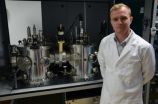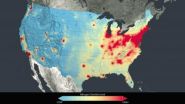(Press-News.org) The chemical used to make tofu and bath salts could also replace a highly toxic and expensive substance used to make solar cells, a University study published in the journal Nature has revealed.
Cadmium chloride is currently a key ingredient in solar cell technology used in millions of solar panels around the world. This soluble compound is highly toxic and expensive to produce, requiring elaborate safety measures to protect workers during manufacture and then specialist disposal when panels are no longer needed.
Now, a University of Liverpool researcher has found that it can be replaced with magnesium chloride, which is extracted from seawater and is already used in products such as tofu, bath salts and for de-icing roads.
Safe and at a fraction of the cost – $0.001 per gram compared to $0.3 – it has also been shown in the study to be as effective as the expensive and toxic alternative.
Physicist, Dr Jon Major from the University's Stephenson Institute for Renewable Energy carried out the research. He said: "If renewable energy is going to compete with fossil fuels, then the cost has to come down. Great strides have already been made, but the findings in this paper have the potential to reduce costs further."
The cheapest solar cells being manufactured today are based on a thin film of insoluble cadmium telluride. Alone, these cells convert less than two percent of sunlight into energy. By applying cadmium chloride to them, this efficiency increases to over 15 percent.
Liverpool research, however, has shown that magnesium chloride can achieve the same boost to efficiency.
Dr Major said: "We have to apply cadmium chloride in a fume cupboard in the lab, but we created solar cells using the new method on a bench with a spray gun bought from a model shop.
"Cadmium chloride is toxic and expensive and we no longer need to use it. Replacing it with a naturally occurring substance could save the industry a vast amount of money and reduce the overall cost for generating power from solar."
INFORMATION:
The study was funded under a grant from the Engineering and Physical Sciences Research Council (EPSRC) and the University of Liverpool.
Tofu ingredient could revolutionize solar panel manufacture
2014-06-26
ELSE PRESS RELEASES FROM THIS DATE:
Deeper insights into protein folding
2014-06-26
Investigating the structure and dynamics of so-called Meso-Bio-Nano (MBN) systems—micron-sized biological or nanotechnology entities—is a rapidly expanding field of science. Now, scientists Alexander Yakubovich and Andrey Solov'yov from MBN Research Centre in Frankfurt, Germany, have produced a new theoretical study of a protein macromolecule changing from a coil structural conformation to a globular one. Their statistic mechanics model, just published in EPJ D, describes the thermodynamic properties of real proteins in an aqueous environment, using a minimal number of ...
New NASA images highlight US air quality improvement
2014-06-26
Anyone living in a major U.S. city for the past decade may have noticed a change in the air. The change is apparent in new NASA satellite images unveiled this week that demonstrate the reduction of air pollution across the country.
After ten years in orbit, the Ozone Monitoring Instrument (OMI) on NASA's Aura satellite has been in orbit sufficiently long to show that people in major U.S. cities are breathing less nitrogen dioxide – a yellow-brown gas that can cause respiratory problems.
Nitrogen dioxide is one of the six common pollutants regulated by the U.S. Environmental ...
Blocking key enzyme minimizes stroke injury, UT Southwestern research finds
2014-06-26
DALLAS – June 26, 2014 – A drug that blocks the action of the enzyme Cdk5 could substantially reduce brain damage if administered shortly after a stroke, UT Southwestern Medical Center research suggests.
The findings, reported in the June 11 issue of the Journal of Neuroscience, determined in rodent models that aberrant Cdk5 activity causes nerve cell death during stroke.
"If you inhibit Cdk5, then the vast majority of brain tissue stays alive without oxygen for up to one hour," said Dr. James Bibb, Associate Professor of Neurology and Neurotherapeutics at UT Southwestern ...
Study: Foreign-trained physicians frustrated at lack of residency positions
2014-06-26
TORONTO, June 26, 2014—Foreign-trained physicians feel there are not enough residency positions for them in countries such as Canada and the United States and this information was not communicated to them before they emigrated, a new study has found.
Researchers at St. Michael's Hospital surveyed international medical graduates to better understand the concepts of "brain drain," the migration of health care workers from low- and middle-income countries to higher-income countries, and "brain waste," where their skills are under-utilized or not utilized in their new country. ...
Lab monitoring tests not always ordered per recommendations
2014-06-26
Why does one physician in a walk-in practice order laboratory monitoring tests for patients more often than a colleague working down the hallway? Which factors influence the use of these important tests that can help doctors ensure that high-risk drugs are prescribed safely? Clues to these questions lie in the age and general health of the patient, and whether the doctor is a specialist or not, says Shira Fischer of the Beth Israel Deaconess Medical Center in Boston. She is the lead author of a study¹ which appears in the Journal of General Internal Medicine², published ...
First-grade teachers using ineffective instruction for math-challenged students
2014-06-26
WASHINGTON, D.C., June 26, 2014 - First-grade teachers in the United States may need to change their instructional practices if they are to raise the mathematics achievement of students with mathematics difficulties (MD), according to new research published online today in Educational Evaluation and Policy Analysis, a peer-reviewed journal of the American Educational Research Association.
VIDEO: Co-author Paul L. Morgan discusses key findings https://www.youtube.com/watch?v=xCAzLGSZ6aM&feature=youtu.be
"Which Instructional Practices Most Help First-Grade Students with ...
Decoding characteristic food odors
2014-06-26
Complementing the five basic tastes of sweet, bitter, salty, sour and umami, a large variety of odors also contribute to the overall sensory impression of a foodstuff. In recent decades, approximately 10,000 volatile food compounds have been identified. Scientists from Technische Universität München (TUM) and the German Research Center for Food Chemistry (DFA) have carried out a meta-analysis on the odorant patterns of 227 food samples.
How cognac gets its complex notes
They were surprised to find that the almost unlimited variety of food smells is based on 230 key ...
Treating gum disease improves vascular health in Indigenous Australians: Study
2014-06-26
A simple non-surgical gum disease treatment markedly reduces the thickness of the wall of the arteries, a risk factor for heart disease, according to a first of its kind study among Aboriginal Australians.
The study findings may be of particular importance to Aboriginal Australians, who in general have poorer oral health and higher rates of cardiovascular disease.
Published in the latest issue of Hypertension, the study reports a significant decline in thickening of the wall of the carotid artery a year after a single session of gum treatment.
"The study shows that ...
Increased nearsightedness linked to higher education levels and more years spent in school
2014-06-26
German researchers have found strong evidence that attaining a higher level of education and spending more years in school are two factors associated with a greater prevalence and severity of nearsightedness, or myopia. Published online this month in Ophthalmology, the journal of the American Academy of Ophthalmology, the research is the first population-based study to demonstrate that environmental factors may outweigh genetics in the development of myopia.
While common, nearsightedness has become even more prevalent around the world in recent years and presents a growing ...
Victoria's volcano count rises
2014-06-26
Geologists have discovered three previously unrecorded volcanoes in volcanically active southeast Australia.
The new Monash University research, published in the Australian Journal of Earth Sciences, gives a detailed picture of an area of volcanic centres already known to geologists in the region.
Covering an area of 19,000 square kilometres in Victoria and South Australia, with over 400 volcanoes, the Newer Volcanics Province (NVP) features the youngest volcanoes in Australia including Mount Schank and Mount Gambier.
Focusing on the Hamilton region, lead researcher ...




